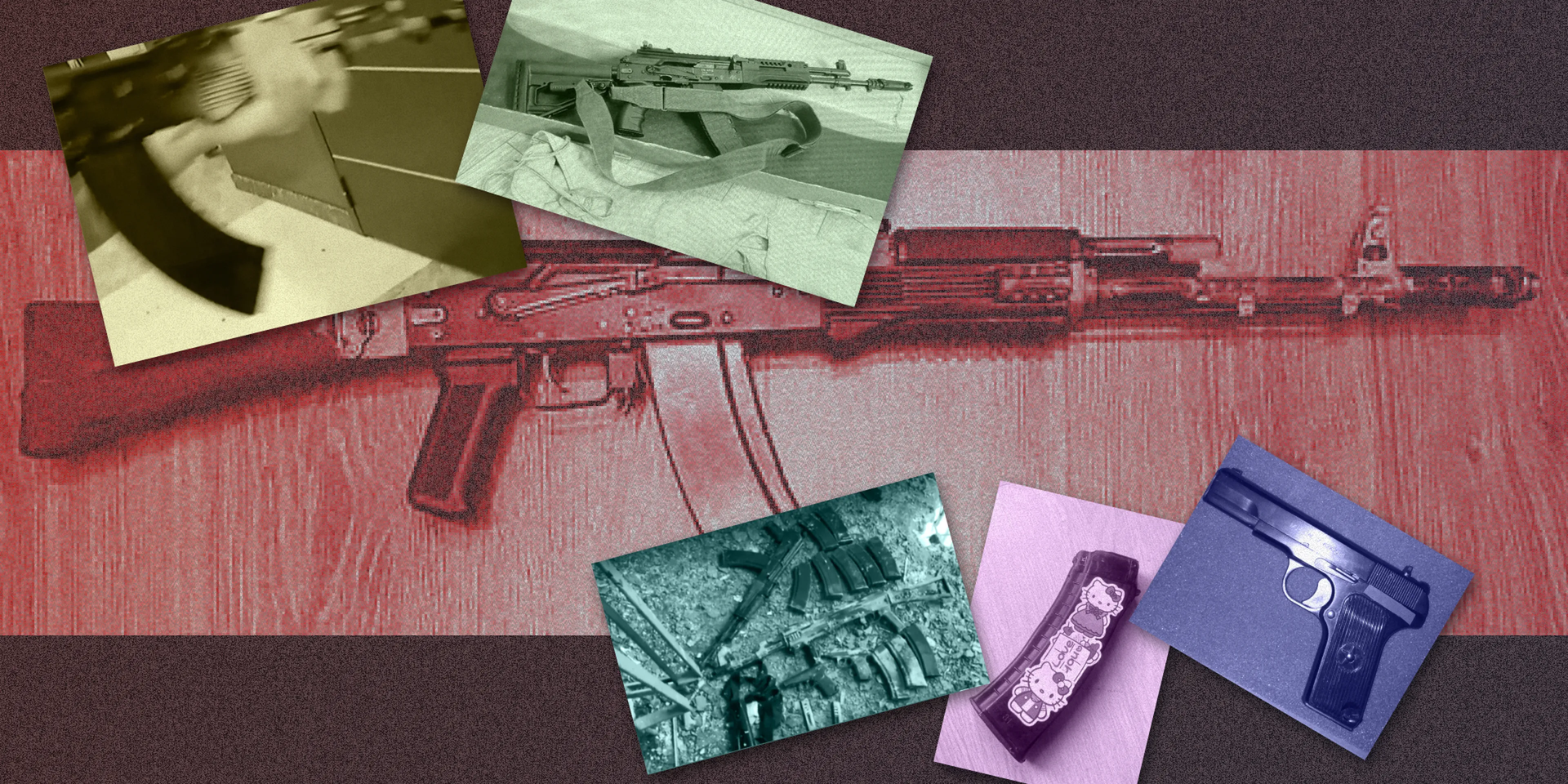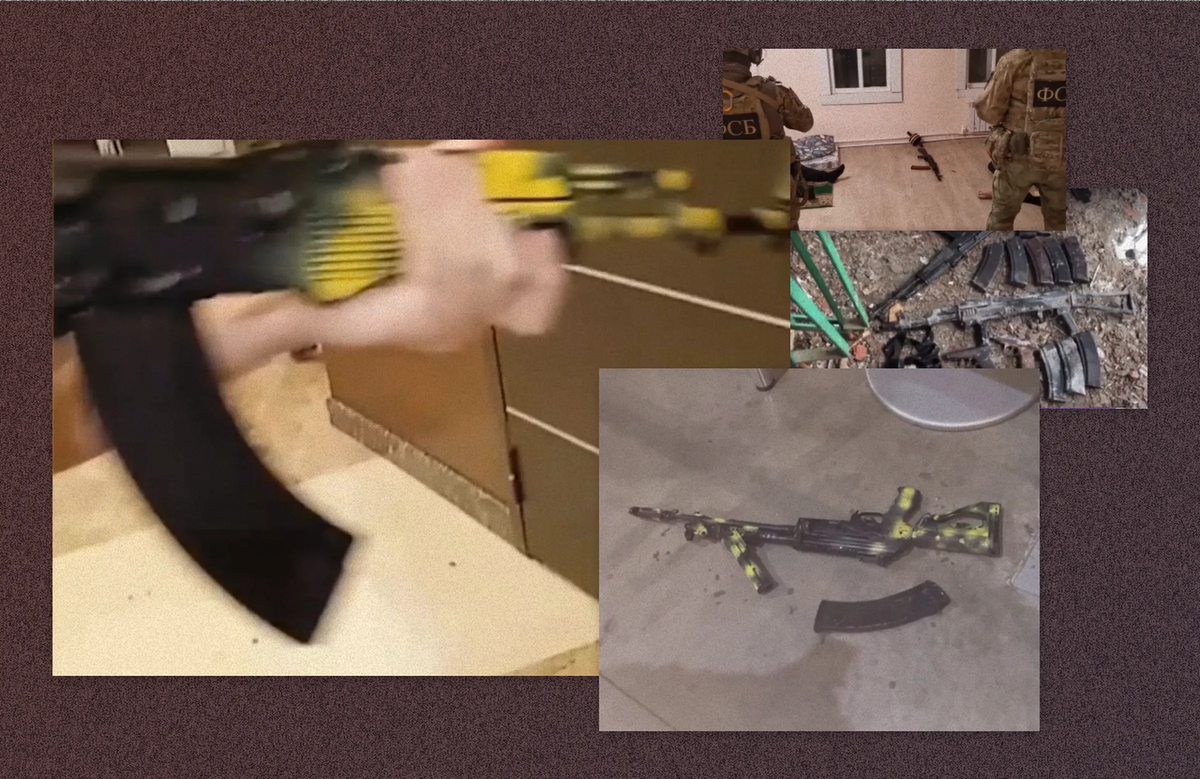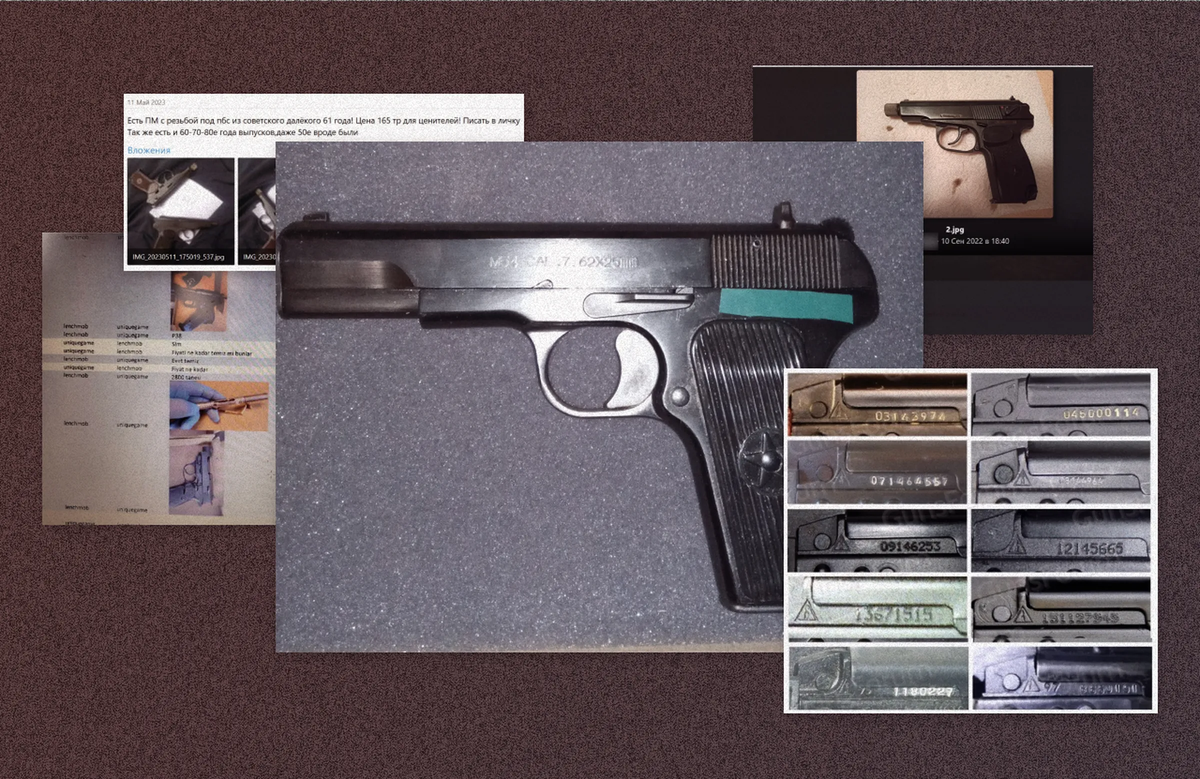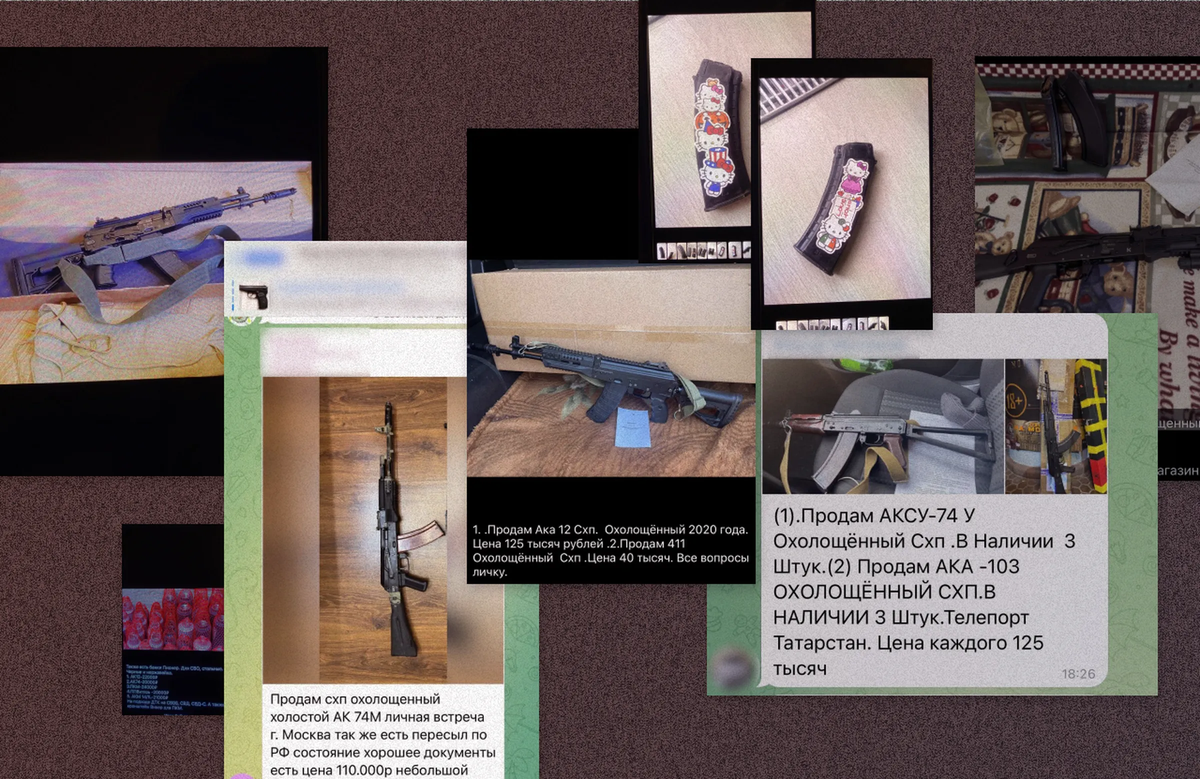“The Soldier Is Dead, and No One Will Miss His Rifle”
Terrorists shot people in Moscow with the newest Russian Army assault rifles. How it became possible and what happens to the black market of firearms during the war in Ukraine

On March 22, four islamists shot dozens of people in Moscow’s concert hall Crocus, set fire to the building, threw their weapons away at the crime scene and escaped. 144 people died and more than 500 were wounded. They were shot with three Russian assault rifles: two AK-74s (at least one of them was an AK-74M) and one AK-12.
These are the 3rd and the 4th generation rifles. The AK-100 rifle family, which includes the AK-74M, was put into service with the Russian army from ’91 to ’99, the AK-12 became a standard service rifle only in 2018. Until now it was unusual for such modern arms to fall into the hands of the Islamic State.
IStories deals with how Russian weapons from the frontline spread on the black market in Russian cities and in Europe to turn into just another tool for terrorist attacks.
“€3,500. Made in Izhevsk.” New AKs in the EU
Buying an assault rifle or a combat pistol without a license in the EU requires neither conspiracy skills nor a lot of money, an arms dealer from Central Europe who introduces themselves as Cate tells IStories.
Back in the early 2010s, the main online arms trade in the EU was on the Darknet — just like in Russia nowadays. But those marketplaces quickly attracted the attention of the police. As early as 2016, European criminal organizations inhabited their own encrypted messenger called Encrochat, which could only be used through an anonymous phone purchased from trusted individuals. The camera, ports, GPS module and microphone were physically removed from the phone. The device itself could not be tied to SIM cards or accounts, and all traffic was routed through the platform’s servers.
The messenger was used by tens of thousands of criminals and all the most serious deals with combat weapons were carried out there, says Lars Winkelsdorf, a German expert for the black market of firearms and legislation in this area.
But in 2020, Europol hacked the messenger. Hundreds of gang members were detained and the Encrochat platform came to its end. Arms trafficking in Europe, meanwhile, flowed into Telegram.

Czechoslovak, Yugoslav and Romanian AK replicas, Makarov pistols, Glocks and ammunition “on the house.” All of this can be found without fantastic efforts in the European and American segments of Telegram for amounts in the range of $500-1200 dollars per gun. To compare, on the Russian Darknet platforms it would cost no less than $2000 for a homemade weapon.
In the EU illegal arms are often sent to customers by mail. “The parcel is stuffed with something strong-smelling, like coffee, and sent just like that. Customs checks are extremely rare and selective, and the risks are low. In Germany, for example, unlike America, there is no specialized arms police, and therefore not enough resources for total control of transactions in messengers. If someone is caught, it’s only individual cases,” Winkelsdorf continues. According to him, the same way with parcels could work for Russians sending weapons stolen from the battlefield in Ukraine.
Despite occasional offers of assault rifles, there is no special interest in them among European buyers. “Here on Telegram we mostly attend to customers seeking self defense weapons like Glocks, Beretta 92f and other hand pistols,” says European seller Cate. In search of something heavier, people sometimes still go to the Darknet.
The main supply channel remains the Balkans, says Lars Winkelsdorf. From there, weapons come to France, and already in French ports an old AK can cost literally $200. But after Russia invaded Ukraine some unusual items are popping up.
“On the black market in Europe now there is a mass of AK-74Ms produced in the 1990s. AK-12s can also be found, but very, very rarely. The price [of the latest AKs] starts at €3,500. Made in Izhevsk [a birthplace of AK rifles and JSC Kalashnikov, formerly IzhMach]. Of course, there are also some old-fashioned AK-74 models from East Germany and [socialist] Poland,” Winkelsdorf shares the results of market monitoring.
A Telegram-channel close to PMC Wagner also wrote about how weapons from the combat zone in Ukraine, including AK-12 and AK-103 (the same AK-74M, but for export), are already available on the black market in the Balkans, as well as Romania and Moldova.
The German expert believes that the new lots on the EU black market are weapons stolen from deadmen in Ukrainian fields: “At the frontline, they get away with it. The soldier is dead, and no one will miss his rifle.”
According to PMC Wagner channel’s version, trophies taken by the Ukrainian armed forces usually end up on the black market in Europe, while Central Asian migrants from one of the Moscow bazaars, Sadovod, are allegedly to blame for combat rifles spreading in Russia.
One of the combat arms dealers interviewed by IStories expresses the same version of foreign smuggling through the Ukrainian army. This point of view, he said, remains mainstream “among the gunsmith community.”
The soldier is dead, and no one will miss his rifle.
Lars Winkelsdorf, on the contrary, considers the sale of trophy weapons by UAF soldiers on the black market abroad unlikely and inexpedient. “Every small arms unit counts, even trophy weapons. Ukraine does not have any extra AKs to sell on the black market.”
At the same time there is a gigantic shadow market for military weapons both inside Ukraine and Russia. Ukraine ranks second in the Global Organized Crime Index in terms of arms trafficking score. The resale of unregistered guns there is at the same pace as in North Korea, Iran, Iraq, Afghanistan, Syria, Somalia, Central Africa and so on. Russia is 0.5% behind. Its black market is comparable to Chad, Mexico, Ethiopia, Turkey and Pakistan.
“Dealers mostly work for the government.” Why Russians need homemade assault rifles. And could IS-terrorists really just assemble their AKs in a garage?
The sale of firearms in the Russian-speaking part of the Darknet is limited to a couple dozen threads on forums. Sellers come and go. Large, proven and long trading dealers cover entire federal districts of Russia, the Center, the Urals and Siberia. They prefer not to expand their geography. It is safer, they explain. “All we need is to find another gunsmith in the Far East,” a user of such a forum jokes.
The Russian-speaking firearms community on the Darkweb offers lots of pistols. Less common are assault rifles. The sale of grenades or explosives on popular Darkweb forums is prohibited. Bestsellers are Makarov pistols (PM). They regularly appear in the FSB footage of terrorist arrests, at least one PM was also with the terrorists in Moscow. Glocks and the Tokarevs (TT) are also popular. TTs in Russia have a bad reputation as the main weapon for criminals because lots of them were spreading across the entire USSR after wars and remained unregistered with the army or the police. In Europe, they are also found in fresh caches of terrorist groups. This spring, the Tokarevs were found in a Hamas cache in Bulgaria.
Customers of such dealers in Russia often explain their desire to get a combat weapon with wordings like “the situation in the country is fucked up and will get worse.” Dealers admit that they often provide services to drug store owners who want to protect their mules. For example, on the evening of April 7, 34-year-old drug courier Vasily Buryakov shot two policemen in the woods near Moscow. Law enforcers seized from him a PM with a silencer mount and a cleanly erased serial number. Exactly the same guns regularly appear in the gun stores of the largest Darknet forum in Russia.
In general, dealers offer restored weapons from the mid 20th century and modified traumatic or blank-firing guns.

Blanks often are just decommissioned regular army guns, which are deactivated by the manufacturer and then sold freely to every adult Russian citizen. Manufacturer inserts studs into the barrel so that no bullet can pass through it, the structure of many components is weakened, the barrel is welded to the frame so that it cannot be replaced with a normal one. As a result, the samples that are handcrafted back to combat condition can shoot, but will hardly be suitable for real combat, if a black market gunsmith behind them does not have enough skill, Darknet-sellers explain to IStories.
“Take the same Retay G17 [Turkish hollow-point version of the Austrian Glock 17]. To turn it back into a combat pistol, you have to drill out the two studs driven into the body that hold the barrel. The stud is metal, but not hardened. The drill shifts a bit to a softer material, which ruins the look of the gun. The barrel on Retay pistols needs to be completely replaced. The magazine also has to be replaced for the 9.19 caliber,” says a dealer who prefers to be presented by his nickname Island. He used to sell weapons on the Darknet, but recently closed the business due to increased attention from law enforcement officers. It is though easier to remodel products from the Tula Weapons Factory than to return combat functions to Glock 17 versions, he adds.
Remodeled Kalashnikov assault rifles have their own problems, too. “There is always a small piece of a stud left, and it will fly out during automatic fire in any case. If the rest of the procedures with drilling and notching were done, let’s say, by a sloppy person, then the safety margin of such an AK is greatly reduced,” says another gunsmith who wished to remain unnamed.
Footage of the Moscow massacre, made by eyewitnesses and the terrorists themselves, shows sparks flying from the barrel of one of the AK-74s. The AK-12 that the militants threw during their retreat was without a forend. The Islamic State newspaper An-Naba wrote that the attackers’ plan was to wait for the Russian special forces to arrive and engage them, but the weapons malfunctioned after 13 minutes of firing and they had to flee. A source close to the FSB’s Special Operations Center also told IStories that the militants, judging by their behavior, intended to die in a firefight with the special forces, but none of the units arrived at the scene.
The experts we interviewed did not agree on the possible reasons for the rifles failure in the hands of the Moscow terrorists.
“I would bet they just loaded the cartridges with poor-quality powder. A blank converted into a real AK can also be a logical explanation. Still, these AKs look more like weapons from the frontline. They have the same camouflage coloring that warring parties resort to,” says Lars Winkelsdorf.
“Sparks fly either with new barrels or very old ones. With new ones, the bullet scrapes along the barrel channels, with old ones, gunpowder gases build up in the barrel channels and fly out. Gun failure is normal, any machine gun jams from time to time. What I can guarantee is that their barrels are clearly not former blanks,” adds Island, a former arms dealer who is familiar with both decommissioned converted rifles, and standard combat models.
Everyone there has their heads already turned on how to collect personal arsenals and sell something.
Both on forums and in interviews, sellers are predicting the imminent end of the converted blanks market. After a series of school shootings across Russia in the late 2010s-early 2020s, Vladimir Putin changed the law on weapons. Those amendments affected specifically the remodeling of decommissioned and traumatic guns. Now the law explicitly defines what is “weapon modification”, and obliges every owner of decommissioned hollow-point weapons to register with the National Guards and present such a weapon for inspection.
Western sanctions and the general economic situation amid the war have also fueled inflation on the black market of weapons. Gunsmiths’ costs are rising by 100-200%, and manufacturers no longer deactivate decommissioned combat weapons to sell them as blanks, they complain.
After the Moscow attack, the FSB rushed to report about how they arrested 130 underground gunsmiths in 48 regions of Russia and seized 500 weapons since the beginning of the year. The footage shows the same remodeled PMs, AKs, restored weapons from World War II, and so on.
But sellers do not see any reasons to wait for a serious pressure on the black market. “Six months after the terrorist attack it will be difficult to find blanks for an adequate price on flea markets. In 2021, the AKSU (shortened version of Kalashnikov-74 with a foldable stock, also called by female name Ksyuha) cost 45-50 thousand rubles ($480-530), now it costs 120 thousand ($1286).” So far this is the only disadvantage that dealers in the market were able to name. Probably, the retired reactivated blanks will be replaced by the real combat weapons from the frontline.
Konstantin Efremov, a former officer of the Russian elite 42nd Motorized Rifle Brigade, who left the army in May 2022 and fled to the U.S., does not understand his former colleagues-in-arms who want to steal more weapons in the combat zone and take them to Russia: “You see, first of all, they are still just kids, these are toys for them. In their wet dreams they have a machine gun, a pistol, a grenade at home. They’ll feel like tough warriors, macho men. Everyone there has their heads already turned on how to collect personal arsenals and sell something.”
Those of the war veterans who did not have time or weren’t quick enough to smuggle firearms are now surprised that they can no longer find decommissioned models on the market. “Guys, does anyone have an option to buy a decommissioned 5.45 AK? Only concrete real offers,” asks a mercenary of the Wagner Group in one of the closed Telegram-chats for the PMC fighters.
A former mercenary of a Chechen Akhmat battalion, who was in prison before going to the frontline, also complains to IStories journalist that he can’t find a blank-firing gun for remodeling. He is not yet ready to pay more than 120,000 rubles for a decommissioned assault rifle made on IzhMach plant.
One of the recent relatively high-profile actions against black market gunsmiths was the arrest of “Papa’s Toys” shop founder Yuri Lvovsky in 2021. This came in the wake of the state’s reaction to the school shooting in Kazan, Tatarstan. The businessman sold components, decommissioned guns and tools for converting blank weapons into combat ones right on the corner of Lubyanka Street, a few steps away from the FSB headquarters. As a result, he ended up in Lefortovo — a Moscow prison unofficially supervised by the FSB.
But that didn’t stop the spread of tools for converting weapons. There are many regional and all-Russian flea markets on Telegram, where private sellers offer the same goods and even more: from the now really desired commissioned rifles and buttstocks for standard army AK-12s to Scandinavian silencers, American radios, and Western equipment for cleaning Russian AKs in the field.
Asked whether dealers are afraid that security forces will come to these flea markets after the terrorist attack, Island says: “There have always been and will always be security forces at flea markets. Dealers there mostly work for the government.”
“You can drop it and lose it or you also can sell it and forget about it.” How Russian soldiers smuggle weapons
“Almost everyone knows that one of the units of one of the [Russian] republics is smuggling weapons from the special military operation zone uncontrollably. And military counterintelligence officers can’t do anything about it. No, they are not turning a blind eye, they just have their hands tied,” a PMC Wagner Telegram channel reacts to the news about Russian rifles in the Crocus massacre in March.
Chechen units are indeed smuggling weapons and ammunition from the combat zone. Back in the spring of 2022 one of the Akhmat “volunteers” from Siberia called an IStories journalist to brag about how he managed to defect with a few F-1 grenades. Another former Akhmat mercenary confirmed to IStories that weapons are still being stolen and smuggled. Not only to the Caucasus, but also to remote regions of Russia, where many of the unit’s fighters live.
But the uncontrolled flow of weapons to Russia is a problem not only for Chechen regiments and battalions.
Senior Lieutenant Efremov describes the smuggling procedure in the first months of the war as follows: “A soldier went from Ukraine to Russia to get some spare parts for machines or to show up to his permanent deployment unit, pretended to be a fool, ’Oh, I forgot I left a grenade in my unloading vest,’ and got away with it. Inspections and body searches are conducted on every checkpoint, but they still manage to do it. If you get caught with a gun to smuggle during the search, they’ll just wag a finger, nothing more.”
There are some offers to buy or sell assault rifles from the war in Ukraine popping up in the Russian-speaking part of the Darknet, but users are a bit suspicious about them and think those messages may have something to do with the FSB provocations. Users suggest that all those who are looking for original combat AKs for a reasonable price shall try their luck in the occupied city of Donetsk: “You can easily find a machine gun in the [self-proclaimed Donetsk People’s Republic] DPR. But not here, on the Darknet. There, personally, talking to the locals.”
Up to 20,000 rubles ($214) for pistols and up to 30,000 rubles ($321) for AKSU.
Numerous eyewitness-reports of attempts to smuggle combat weapons from Ukraine to Russia are not reflected in the official statistics of criminal cases as a mass phenomenon. According to data from the Russian Supreme Court, the number of crimes recognized as arms and explosives trafficking and manufacturing has been generally decreasing over these two years. In 2020, the courts received 8,800 such cases, in the first year at war, 2022, there were only 8,000 such cases, in the first half of 2023 it’s 4,500 registered cases.
At the same time, in the first six months of 2023, 49 servicemen of the Russian Armed Forces received sentences for illegal trafficking of weapons and explosives. Before the war, in 2021, there were only 13 such convicts from the ranks of the Russian army.
But the changes are clearly visible from the court rulings. Among the materials published by the courts there are several stories of servicemen who tried to transfer stolen or trophy weapons to acquaintances in annexed Crimea or sell them directly in the occupied territories. Apparently, this practice has been in place since the beginning of the war. “It is easy to take out weapons if you are a driver of someone high-ranking, for instance a general or a security service officer. Or if you have friends with a special badge who can come to you in Crimea. Then you can drive through all the traffic police checkpoints in Russia with this badge,” says former senior lieutenant Efremov.
In the annexed regions of Ukraine, fighters sometimes actually give away their weapons for a dime.
“Before the war a pistol could be dumped for 50-100 thousand rubles ($534-1069), it depended on the region and the brand of the barrel. Then already in the combat zone, when selling to a middleman in person, the prices in some rare cases were dropping to 20,000 for pistols and up to 30,000 for AKSU,” Efremov continues.

The gunsmith nicknamed Island adds that on the Darknet, military weapons will always be sold at a consistently high price, regardless of their origin. “AKSU [on the darknet] can’t even cost 50,000. From 180,000 to infinity, depending on the seller. I myself sell ’Ksyuha’ for 240,000. In general, weapons from the combat zone did not affect pricing in Russia,” he says.
According to the dealer, there are several options to deliver a gun from the occupied territories of Ukraine to Russia. Some fellow travelers, caches or even by mail. Occasionally also by figureheads, who can buy a weapon for some other third person. Sellers call them drops. “But a drop can screw a person higher up in the chain and then up to the end.”
Russian court archives already contain criminal records against such couriers and drops. In November 2023, a 41-year-old resident of the Penza Oblast received a three-year suspended sentence for illegal arms trafficking. He went to Pervomaysk in the occupied Luhansk Oblast as a volunteer to help wounded locals and allegedly just accidentally found among the ruins of a building an AK with a 30 rounds loaded magazine, a box with additional 120 rounds of ammunition and two hand grenades. He buried the weapons in the cache on his way out of the town and took them on his next trip there with humanitarian aid, but was stopped by border guards in Voronezh Oblast, Russia.
According to Efremov, fighters sell weapons stolen from their own deadmen or from the enemy, but never touch their regular standard assault rifles:
“They could strip a Ukrainian arms depot and then use trophy weapons in action. After all, if you lose a gun registered in your military ID, there will be problems. Fighters take trophy weapons at the first opportunity, and put the standard ones under lock and key. Commanders of all degrees are okay with this. You better let your soldiers run with a trophy, than lose their own rifles. And then you can drop it and lose it or you also can sell it and forget about it. Soldiers and sergeants dream of getting their own pistols, the Stechkins and PMs. Because only officers are entitled to pistols. If you have a PM, you are a cool kid, a cowboy, a sheriff. Rear bums like to trophy small AKSU’s so they don’t have to cart around a heavy paddle [full-size AK, Russian military slang]. F-1 and RGD grenades are like shit, they are stolen in weapon boxes.”
People IStories spoke to define the popularity of weapons in the occupied territories by demand as follows: pistols, grenades, compact AKSU’s and only then full-size AKs. “Paddle is the last thing a civilian would want to buy. Unless there is a demand for TNT from the combat zone, I guess,” says Efremov.
While the AK-74M that the Moscow terrorist used has been exported to almost all parts of the world and is even produced under a franchise in Pakistan, their other weapon, the AK-12, was by now only sent to Russian special forces and some quasi-PMCs.
“AK-12s do not make up even 10% of all the boomsticks in the regular units of the Defense Ministry. Such rifles are for scout units, but no one likes it for its heavy weight. It’s like carrying a crowbar, the preference is still given to AK-74M with a plastic stock,” says Efremov.
In various quasi-PMCs, the AK-12 are sometimes given to the fighters against their will, and they are looking for an opportunity to get rid of this weapon and get an acceptable gun like the AK-74M instead, says another soldier, who fought against Ukraine as a mercenary. No one traces the path of exchanged AK-12s in the fog of war.
German expert Lars Winkelsdorf believes that the Islamic State terrorists from Crocus got their hands on the new Russian assault rifles by accident, buying the available goods not on the Darknet, but literally from under the table. He is wary of what is happening on the Russian black market: “This is not yet an influx of weapons. Things will only get real as soon as the war is over. We have already seen it after Yugoslavia.”